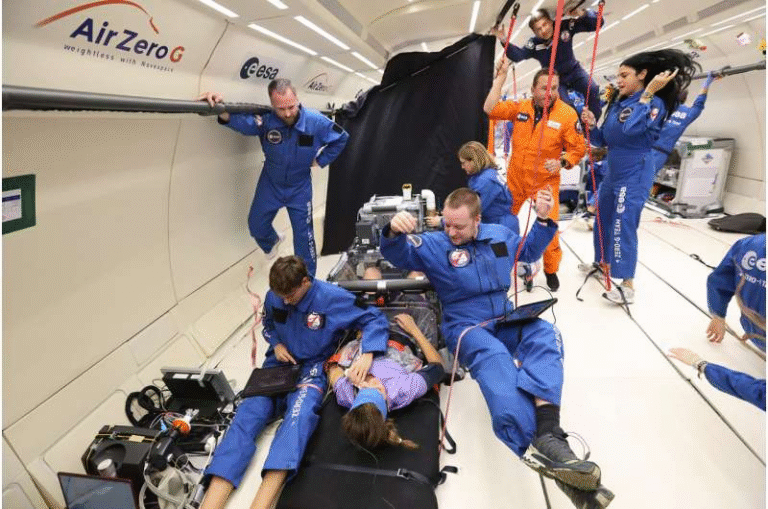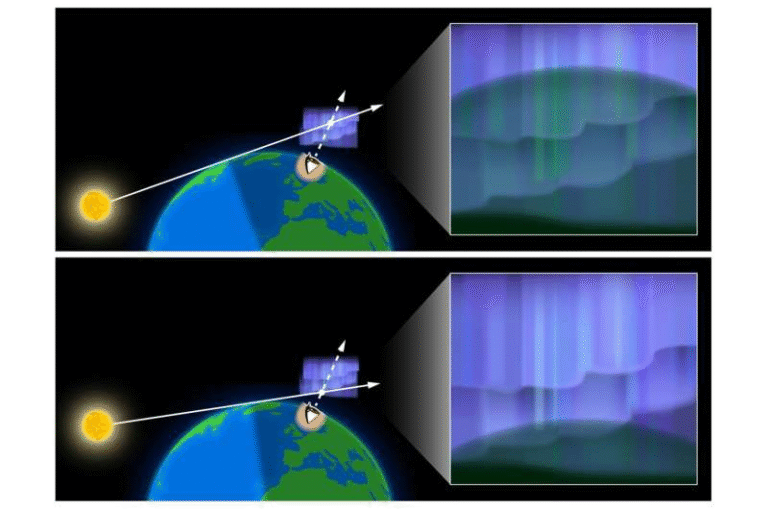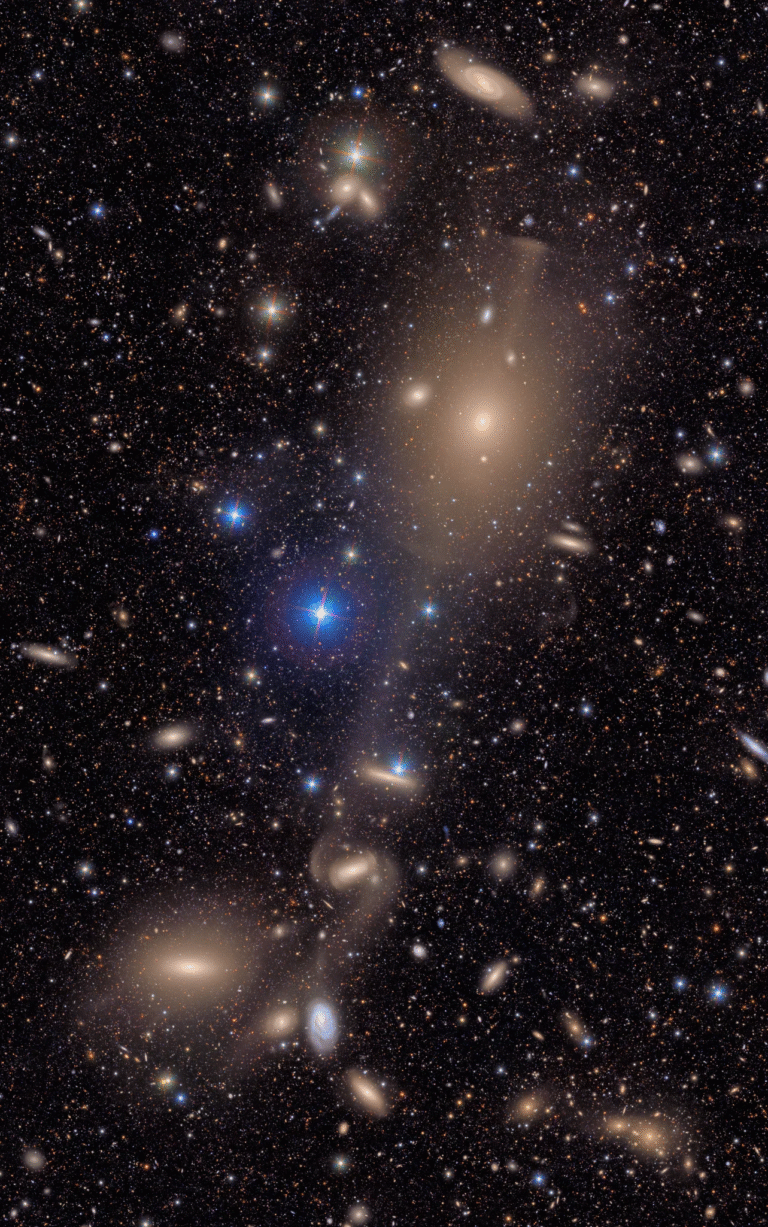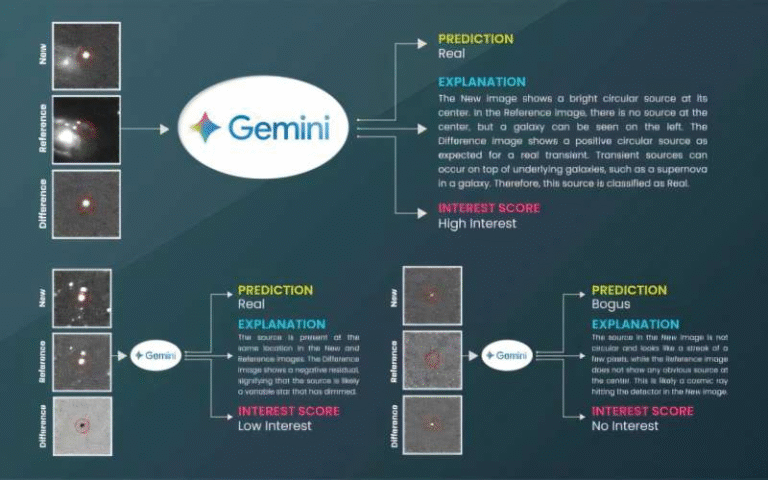Webb Telescope Detects Methane Gas on Distant Dwarf Planet Makemake

The James Webb Space Telescope (JWST) has delivered another fascinating discovery: the detection of methane gas on the distant dwarf planet Makemake. This is the first time gas has been directly confirmed on Makemake, making it only the second trans-Neptunian object after Pluto with a proven gas component. A research team led by the Southwest Research Institute (SwRI) used JWST’s Near-Infrared Spectrograph (NIRSpec) to make the detection, and their findings reveal that Makemake may be far more dynamic than previously thought.
What Exactly Was Detected
JWST observations revealed sharp methane emission peaks near 3.3 microns in the near-infrared spectrum. These peaks represent solar-excited fluorescence — in other words, sunlight absorbed by methane molecules and then re-emitted. This is a strong indicator that methane exists not only as surface ice but also in a gas phase above Makemake’s surface.
The data shows that Makemake’s surface is composed of a chemically complex mixture. Along with methane ice, researchers found signatures of:
- CH₃D (a methane isotopologue containing deuterium)
- Methanol (CH₃OH)
- Hydrocarbons like acetylene (C₂H₂) and ethane (C₂H₆)
- Possible traces of ethylene (C₂H₄)
These molecules are thought to form through photochemical processing of methane ice by solar radiation and cosmic rays.
To interpret the spectral data, scientists tested two main models: an areal mixture (different ices distributed side by side) and a layered mixture (methane ice overlying processed hydrocarbons). The layered mixture gave the best match to the JWST results.
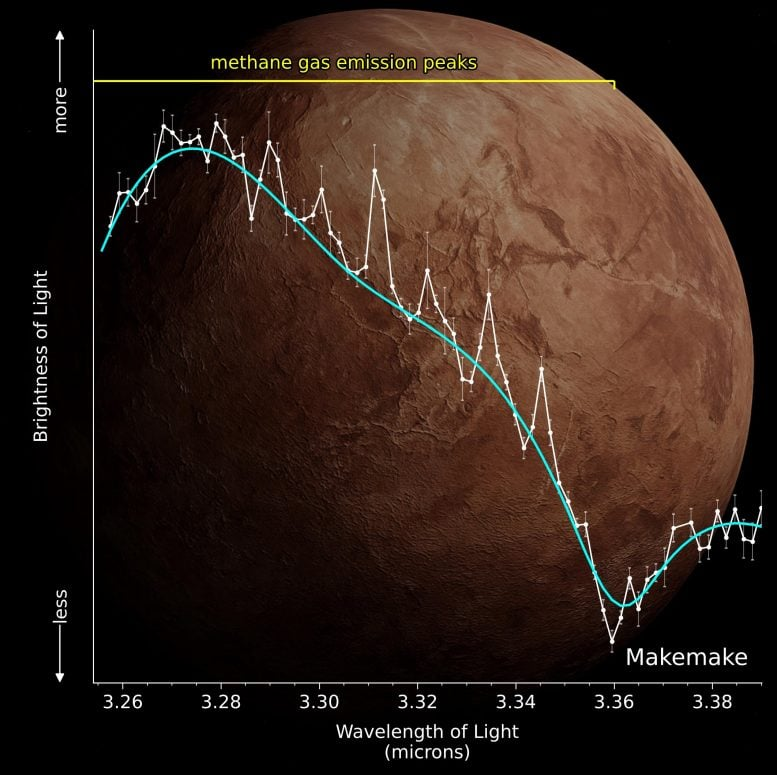
How Big is Makemake?
Makemake is about 890 miles (1,430 km) across, making it roughly two-thirds the size of Pluto. It is one of the brightest known objects beyond Neptune, reflecting a large portion of the sunlight that hits it. Classified as a dwarf planet in the Kuiper Belt, Makemake was discovered in 2005 and named after the fertility god of the Rapa Nui people of Easter Island.
Its surface is dominated by frozen methane, nitrogen, and other ices. But until now, no direct evidence of atmospheric gases had been found. Stellar occultation studies (where Makemake passes in front of a star, briefly blocking its light) suggested it lacked a thick global atmosphere, though a thin one could not be excluded.
Two Possible Explanations for the Methane Gas
The newly observed methane gas could come from two main sources:
1. A Tenuous Atmosphere
One explanation is that Makemake has a very thin, gravitationally bound atmosphere produced by the sublimation of methane ice. In this scenario:
- Gas temperature is estimated around 40 Kelvin (about −233 °C).
- Surface pressure would be roughly 10 picobars, which is 100 billion times lower than Earth’s atmosphere and about a million times thinner than Pluto’s.
This kind of atmosphere would be extremely fragile but still represent an active exchange of material between surface ice and the space above it.
2. Localized Plume Activity
The other possibility is that methane is being released in short-lived, plume-like bursts, similar to cryovolcanism or cometary outgassing. If that is the case, models suggest that Makemake could be releasing methane at a rate of 0.2–1.6 × 10²⁸ molecules per second — equivalent to a few hundred kilograms of methane per second.
For comparison:
- That’s on the scale of the vigorous water plumes on Saturn’s moon Enceladus.
- It is much stronger than the faint vapor activity detected at Ceres in the asteroid belt.
If true, Makemake could be one of the most active icy worlds beyond Neptune.
Why This Discovery Matters
The detection of methane gas reshapes how scientists view Makemake. For years, it was considered a frozen, mostly inert relic of the early Solar System. Now, evidence points toward it being geologically or atmospherically active.
This has several implications:
- It suggests that volatile ices are still evolving on Makemake’s surface.
- It raises the possibility that other dwarf planets may also host thin atmospheres or plume activity.
- It strengthens the idea that Kuiper Belt objects are dynamic worlds, not just leftover debris.
The methane also provides insight into the deuterium/hydrogen (D/H) ratio of Makemake’s ices. JWST measurements suggest a D/H ratio of around 4 × 10⁻⁴, which is consistent with earlier studies. This value gives clues about the chemical history of Makemake — whether its methane was trapped from the primordial solar nebula, produced internally, or modified by radiation.
Past Clues: Thermal Anomalies
Interestingly, Makemake has shown unusual thermal anomalies in previous infrared observations. A mid-infrared excess at wavelengths of 18–25 microns hinted at the possibility of localized hot spots, possibly due to:
- Enhanced methane sublimation
- Cryovolcanic activity
- Or even the presence of a dust ring
These anomalies were unexplained until now. The methane detection gives scientists new evidence that volatile activity may be driving these thermal irregularities.
How the Data Was Collected
The observations came from JWST’s Near-Infrared Spectrograph (NIRSpec), covering a wavelength range of 1.0–4.8 microns. The dataset was part of Program 1254 (PI: A. H. Parker).
The high sensitivity of JWST allowed the detection of faint gas signatures that previous instruments could not pick up. However, the researchers note that the current dataset has limitations:
- Spectral resolution is not high enough to fully separate overlapping gas features.
- Background noise introduces uncertainty in distinguishing between atmospheric gas and plume models.
Future JWST observations at higher resolution will be necessary to settle the debate.
What Comes Next
To confirm the methane’s origin, scientists plan to:
- Conduct higher-resolution JWST spectroscopy to resolve finer details of methane emission lines.
- Monitor Makemake for temporal changes in methane emission. If variability is detected, that would support the plume-activity model.
- Continue refining surface-composition models to better understand the interaction between ice, radiation, and outgassing.
The outcome could determine whether Makemake joins Pluto as another world with a permanent (though thin) atmosphere, or whether it is more like Enceladus, with intermittent, powerful plumes.
Makemake in the Context of the Kuiper Belt
Makemake is part of the Kuiper Belt, a vast region of icy objects beyond Neptune. Other well-known members include Pluto, Eris, Haumea, and countless smaller bodies. These objects are remnants of the early Solar System and preserve information about its formation.
Most Kuiper Belt objects are far too small or faint to study in detail. This is why JWST’s detection of methane gas on Makemake is such a milestone. It opens the door to studying atmospheric processes in this distant region and may even shed light on conditions in the early Solar System.
Why Methane is So Important
Methane is one of the most volatile and chemically active molecules found in icy bodies. On planets and moons, methane ice can:
- Sublimate directly into gas when heated.
- Be broken down by sunlight into more complex hydrocarbons.
- Serve as a tracer of geological and atmospheric activity.
For instance:
- On Pluto, methane helps sustain a thin, nitrogen-dominated atmosphere.
- On Titan (Saturn’s largest moon), methane cycles like water does on Earth, forming lakes, rain, and clouds.
- On Enceladus, methane has been found in its water vapor plumes, sparking discussions about possible subsurface chemistry.
Finding methane gas on Makemake links it to this broader family of volatile-rich worlds and raises new questions about how active the outer Solar System really is.
Final Thoughts
The Webb Telescope’s detection of methane gas on Makemake is more than just a technical milestone — it is a reminder that even the most distant, icy objects in our Solar System can be surprising and active. Whether Makemake has a fragile atmosphere or explosive plumes, one thing is clear: it is not just a silent chunk of ice. It is a living world with processes still unfolding today.
With further JWST observations, scientists will get closer to answering the big questions: Does Makemake breathe through a thin atmosphere, or does it vent through icy geysers? Either way, we now know that Makemake is far more intriguing than we once imagined.

